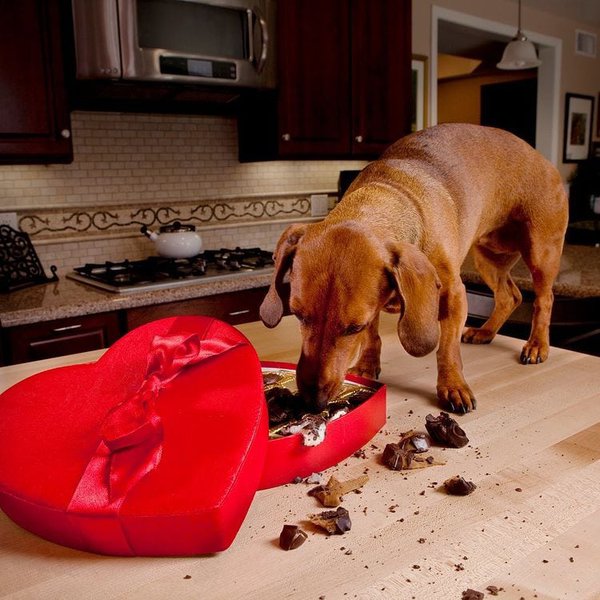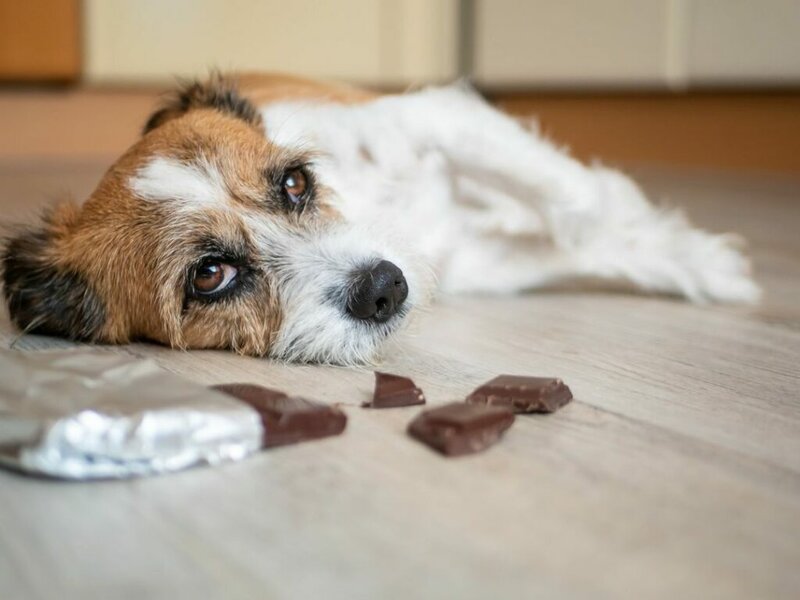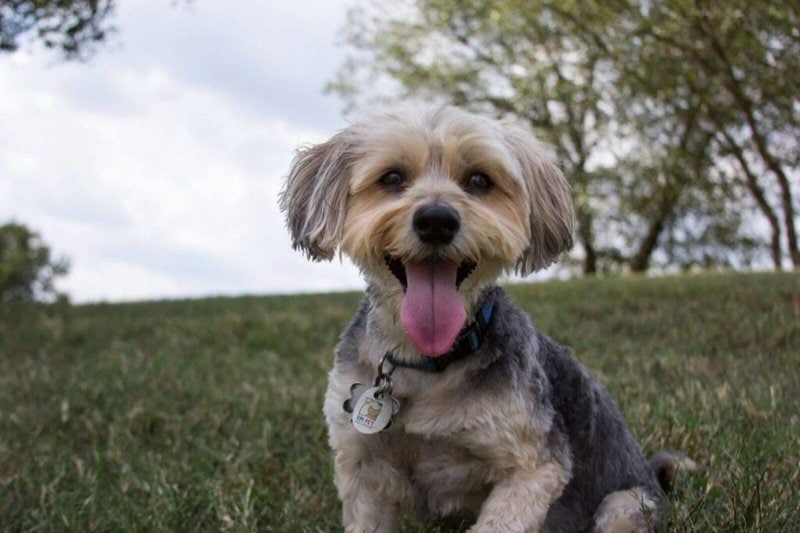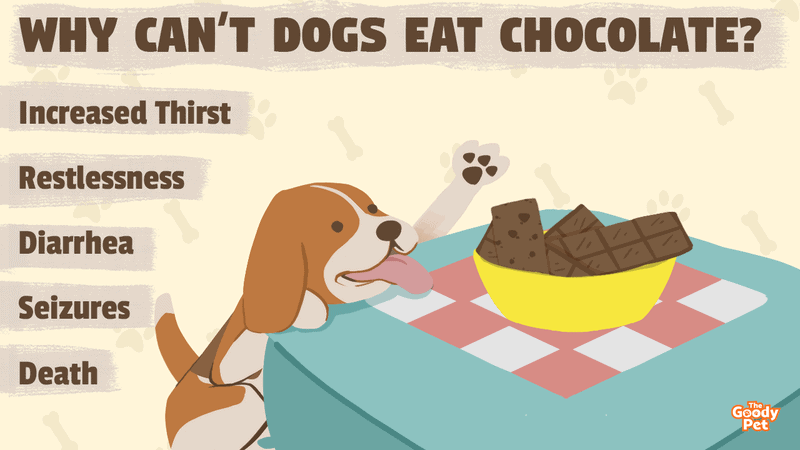Chocolate remains one of nature’s well-loved foods humans enjoy. Aside from tasting and smelling good, it lifts our moods and spirits due to the chemicals present in this sweet confection that stimulates our brain. But, why can’t dogs eat chocolate? Why is it considered dangerous to our furry babies?
Dogs cannot eat chocolate because of two toxic components namely, theobromine and caffeine. Dogs simply cannot metabolize theobromine as well as we humans can. Caffeine shares a chemical structure similar to theobromine and it is part of a group of chemicals known as methylxanthines, which is also poisonous to dogs.
Together with garlic, onions, avocado, and grapes, chocolate is considered one of the most dangerous foods that your dog can ingest and remains in the Top 10 foods your dogs must avoid.
In this article, we will tackle the effects of chocolate on your dogs, the things you can do to prevent chocolate poisoning, and the treatment performed by veterinarians in case they accidentally ingest it.
What Happens If Dogs Eat Chocolate?

Chocolates, being one of the forbidden treats for dogs, can be very fatal. The effects of chocolate poisoning could be apparent in a matter of 6 to 12 hours and could last for up to 72 hours or more.
While dogs can eliminate half of the caffeine they ingested in 4.5 hours through their urine, theobromine takes much longer to withdraw from their bloodstream.
It takes 10 hours for theobromine to reach peak serum levels in their blood and 17.5 hours to eliminate even half of it.
While these methylxanthines are present in their blood, it acts as a stimulant that makes our dogs restless and shows signs of hyperactivity.
Signs of chocolate toxicity include the following:
- Nausea or vomiting
- Diarrhea
- Increased urination
- Increased thirst
- Continuous panting
- Restlessness
- Elevated heart rate
- Muscle tremors
- Seizures
- Collapse and coma
- Death
How Much Chocolate Is Considered Poisonous To Dogs?
The level of chocolate toxicity depends on the amount of chocolate eaten and the weight of dogs.
Smaller dogs can experience chocolate poisoning from as little as 1.8 oz of milk chocolate or around 4 tablespoons.
Medium-sized to larger dogs, on the other hand, will see severe signs of toxicity at around 14 oz which is roughly nine pieces of small chocolate bars.
As an example, a small bar of chocolate may only cause mild symptoms to a Saint Bernard, a similar amount could prove to be lethal to a Miniature Pinscher.
Since chocolate toxicity is quite common among dogs, several websites offer online chocolate toxicity calculators that let you know how much is enough for your particular dog. It takes into account the kind and amount of chocolate your dog ingested, as well as, the weight of your dog.
It should also be noted that while your dog may have ingested small amounts of chocolate at one particular time, repeated exposures to chocolates over a period of time could lead to cardiomyopathy.
This is a condition when the heart cannot effectively pump blood to other parts of the body.
Are All Types Of Chocolates Toxic For Dogs?

Yes, all types of chocolate are toxic to dogs with white chocolate being the mildest of all and most unlikely to cause chocolate toxicity.
In simpler terms, the more bitter and darker the chocolate is, the more theobromine content it has.
Dark chocolate, for example, is ten times more potent than milk chocolate.
White chocolates, although having trace amounts of theobromine, are high in fat and sugar. These can cause problems such as pancreatitis and stomach upsets.
All types of chocolates originate from cacao beans. Chocolate liquor is produced after the cacao beans are grounded. And, it is this liquor that determines the amount of theobromine present in different types of chocolates.
Listed below are the types of chocolate according to theobromine content in descending order:
- Cacao powder
- Unsweetened baker’s chocolate
- Semisweet chocolate
- Cocoa powder
- Dark chocolate
- Milk chocolate
- White chocolate
You may be asking ‘what are those supposed dog treats with chocolates, are these safe for my dog?’
Some dog treats contain the ingredient carob which closely resembles chocolate in color. It may confuse you to think that it might be toxic to your dogs.
Carob came from bean pods of the carob tree and does not contain theobromine or caffeine, even though giving too much carob may result in some tummy distress.
What Do I Do If My Dog Ate Chocolate?
If you suspect your dog to have eaten chocolate, call your veterinarian immediately. It is better to be safe than sorry before the symptoms of chocolate toxicity appear.
Your veterinarian may ask you to monitor your dog for any signs of toxicity like restlessness, vomiting, or muscle tremors.
You should also remove any traces of chocolate within the vicinity of your dog. And if it is still eating the chocolate, confiscate the chocolate and wash any traces of it from its mouth.
You should also take note of the amount and type of chocolate your dog consumed and when. Usually, symptoms would appear as early as two hours if your dog ate a sizable amount for its weight.
Also, if your dog is pregnant, elderly, or has other health concerns, it is recommended to bring it to the veterinarian right away. Theobromine can affect an unborn puppy through the placenta.
If your veterinarian is not available, you can call a pet poison hotline or a local emergency veterinary clinic.
What Is The Treatment For Chocolate Toxicity?
The first thing a veterinarian would do in treating chocolate toxicity is by inducing vomiting to remove chocolate from the dog’s stomach or gastric decontamination.
This is done through the use of an emetic called apomorphine that can be administered intravenously or by placing it directly through the eyes for faster absorption.
The veterinarian may give the dog afterward a few doses of activated charcoal to help bind any remnants of chocolate in the stomach and poop it out. It helps theobromine not to be absorbed into the bloodstream.
Additional medications and intravenous fluid therapy may be given to lessen other specific symptoms.
The medicine could be Diazepam for seizures and anxiety or beta-blockers to slow down the heart rate. For some cases, Atropine is administered to increase heart rate and reduce salivation.
Hospitalization may be necessary if the symptoms are severe.

How Do I Prevent My Dog From Eating Chocolate?
Dogs have a sweet tooth because of sweet receptors located in their tongues. These receptors make them indiscriminate eaters that would not have second thoughts of grabbing anything and eating it.
There are several things you can do to prevent your dog from eating chocolate, especially during the holidays. This is the time when everything seems to be so hectic that you do not notice your pooch already eyeing something.
Store It
Keep chocolate candies and other chocolate products out of reach from dogs.
Store it in the cupboard or anywhere your dog cannot reach and place it in a container with a lid to make sure everything is secure.
Send Reminders
Tell your guests and children not to give fido anything that has chocolate in it. Inform them of the dangers involved regarding chocolate toxicity even if given in small amounts.
Crate Train It
Train your dog to be comfortable inside a crate when you do not have the time to supervise or look after it. It keeps them safe from eating unwanted foods lying around the house.
“Leave It”
Teach your dog the command “leave it” to prevent it from eating anything that is within easy reach.






